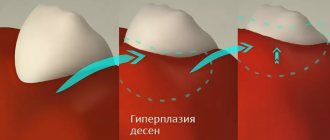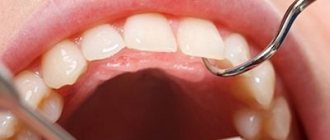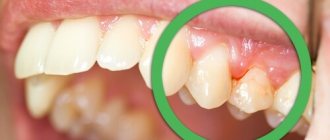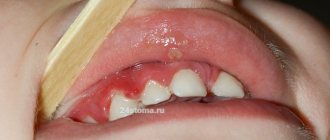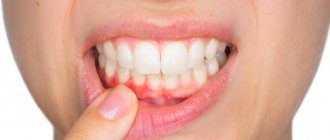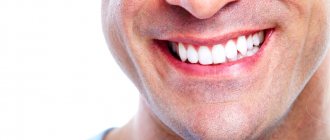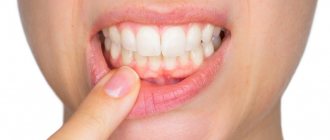Causes of gingivitis
The most common cause of gingivitis is poor personal oral hygiene. Violation of the rules may consist of inappropriate technique, irregular brushing of teeth, refusal to use dental floss and rinses after meals. As a result, food particles accumulate between the teeth, and a large amount of soft plaque forms on the surface of the teeth. This is a favorable environment for the proliferation of bacteria, which leads to the inflammatory process.
Soft plaque, which is not removed for a long time, mineralizes and hardens over time. When tartar appears, pathogenic microorganisms also actively multiply on it. In addition, the sharp edges of hard deposits injure the gum margin, which reduces local protective factors.
There are other common local causes of gingivitis:
- unsound orthopedic, orthodontic structures: braces with sharp edges,
- chips of enamel, destruction of teeth and fillings: injury to mucous membranes with sharp edges;
- teething disorders, dental caries, pulpitis, periodontitis, abscesses and other diseases;
Systemic pathologies and certain conditions can lead to the development of gum inflammation. The most common ones are:
- endocrine diseases - diabetes mellitus, Graves' disease, etc.;
- diseases of the digestive system - gastroesophageal reflux, Crohn's disease, chronic cholecystitis, etc.;
- hypovitaminosis, lack of minerals due to a strict diet or impaired absorption of nutrients;
- taking certain medications - antidepressants, local vasoconstrictors, antibiotics, combined contraceptives, beta-blockers, etc.;
- past infections and surgical interventions;
- puberty, pregnancy, menopause - changes in hormonal status not associated with illness;
- allergic reactions to food, medicines, hygiene products;
- bad habits.
Often there is a combination of factors - a combination of local and general causes of weakening of immune forces. You can find out the exact reasons only with the help of a doctor.
Ask a Question
Hypertrophic gingivitis
The essence of the disease is reflected in the name - the gums and gingival papillae grow and become oversized. This occurs either through tissue swelling or due to internal proliferation of connective tissue with the formation of scars - fibrosis.
Accordingly, hypertrophic gingivitis can be edematous and fibrous.
The incentives are:
- Hormonal changes in the body during pregnancy;
- Injury to the gums by the edges of dentures and crowns;
- Progression of catarrhal gingivitis;
- Changes in hormonal levels during adolescence.
Edema form of gingivitis
This type of disease is often associated with internal changes in metabolism in women and growing children. The interdental papillae look loose and engorged. At the beginning of treatment, the oral cavity is sanitized, plaque and stones are removed, then anti-inflammatory procedures begin.
Sclerotization is most often used. After applying anesthesia, a special solution containing calcium chloride, magnesium sulfate and glucose is injected into the patient’s gums. The course takes 6-8 days with one or two day breaks.
Advanced swelling of the gums can change; the patient’s mucosa becomes scarred with the formation of fibrous cords.
Fibrous form of gingivitis
The source of troubles are internal changes in living tissues. Surgery is indicated here; unfortunately, fibrosis is not amenable to conservative therapy. First, external irritants are corrected - tartar is removed, the shape of the crown is corrected. Then the hypertrophied tissues are excised. Subsequently, healing bandages are applied.
Symptoms and consequences
Symptoms of gingivitis are determined by stage. The disease can begin with the following manifestations:
- swelling, redness, looseness of the gums;
- increased sensitivity of tissues, bleeding during brushing teeth and eating due to fragility of blood vessels;
- pain when chewing and touching;
- bad breath.
As the disease progresses, the necks of the teeth may become exposed, which leads to increased sensitivity of the teeth - it becomes difficult to accept hot and cold drinks and foods. The pain also increases over time, and severe difficulty chewing food may occur. In addition to general symptoms, there are also specific ones characteristic of a particular type of gingivitis.
The consequences of gum inflammation can be very serious: the pathological process often spreads to the ligamentous apparatus of the tooth, and periodontitis occurs. This condition is dangerous due to the mobility of teeth and the high probability of their loss. A chronic focus of inflammation in the mouth is a risk factor for the development of diseases of the ENT organs.
Gingivitis – gum disease
Gingivitis is the most common gum disease, which is characterized by redness, bleeding of the gums, and swelling. According to statistics, only 3% of the population have completely healthy gums. To get into this percentage, you need to take care of your gums and regularly see a doctor so as not to miss the initial signs of the disease.
Gingivitis is a stage of gum disease when it is still possible to prevent the development of the inflammatory process and completely stop it. The next stage is periodontitis, in which inflammation spreads to the following periodontal tissues. After the onset of periodontitis, a complete cure is no longer possible; here we are talking about relieving the symptoms, bringing the disease into remission and delaying the situation when it is necessary to remove teeth. In this regard, it is necessary to be attentive to the health of the gums, to prevent their disease, and if problems arise, immediately consult a doctor to prevent serious damage to the periodontium.
Types of gingivitis
Gingivitis can be acute or chronic. In the first case, noticeable symptoms occur. Chronic forms are characterized by mild symptoms, pain is absent or minimal. Periodic slight bleeding of the gums during brushing and halitosis may occur. It is important to understand that sluggish gingivitis is characterized by periodic exacerbations.
Inflammation of the gums is classified not only by its form, but also by the nature of its course.
Catarrhal gingivitis
Catarrhal gingivitis is characterized by redness of the gum area. Itching and bleeding due to mechanical action and mild pain may occur. This is the most common and easiest to treat type of inflammation. Quite often it acts as the initial stage of development of other forms.
Ulcerative gingivitis
Necrotizing ulcerative gingivitis is characterized by the formation of open ulcers, death of areas of gum tissue, and strong bad breath. One of the typical symptoms is the appearance of a grayish coating. The disease is more difficult to treat; in the absence of timely assistance, purulent foci and severe necrosis may appear.
Hypertrophic and atrophic gingivitis
Ulcerative-necrotic gingivitis is followed by hypertrophic gingivitis - excessive growth of tissues occurs that cover the crowns of the teeth. There is keratinization of areas of the gums.
The atrophic form of the disease, on the contrary, is characterized by a decrease in the level of the gums and exposure of the necks of the teeth. This condition is dangerous due to the loss of healthy teeth.
Desquamative gingivitis
This type of inflammation is characterized by abundant desquamation of the gum epithelium. Distinctive features are pronounced redness and noticeable peeling areas of the surface of the mucous membranes.
Differential diagnosis
To make a correct diagnosis, the doctor must draw up a clinical picture of the course of the disease, carefully listening to all the patient’s complaints. The fact that with any form of gingivitis there are no changes in periodontal bone tissue helps differentiate gingivitis from other gum diseases. Therefore, gingivitis is easy to distinguish from both periodontitis and periodontal disease; you just need to do an X-ray examination. With periodontitis and periodontal disease, the image clearly shows destructive changes in the bone tissues of the periodontium. With gingivitis, bone tissue is not affected, inflammation affects only soft tissue.
Differential diagnosis of hypertrophic gingivitis lies in the need to differentiate various forms of the disease, in particular, catarrhal, ulcerative and hypertrophic:
- With catarrhal gingivitis, the gingival papillae are swollen and hyperemic, but not overgrown.
- In the hypertrophic form, the edge of the gum grows quite strongly and covers more than half of the crown of the teeth, the gum often has a bluish tint, and the edge of the gum forms false periodontal pockets.
- In case of ulceration, the gum epithelium is covered with small bleeding and painful ulcers.
Diagnostic features
Gingivitis can be recognized visually—sometimes one examination by a doctor is enough. But you should make sure that there are no more serious pathologies, so diagnosis may include not only a visual assessment of the condition of the oral cavity, but also other measures:
- collecting anamnesis, assessing the condition of structures in the oral cavity;
- probing of periodontal pockets if present;
- determination of tooth mobility;
- electroodontodiagnosis to determine the condition of the dental pulp;
- panoramic x-ray or targeted x-ray - to exclude periodontitis, periostitis and other pathologies of deep structures, jaw bone tissue, etc.
It is important to take into account the presence of chronic diseases and medications. Only with complete information can a doctor make an accurate diagnosis and develop an effective treatment regimen.
Tests to diagnose gingivitis
The Schiller-Pisarev test is based on identifying the volume of glycogen in the gum. If the gums are healthy, then glycogen is not contained in it, but in the presence of an inflammatory process it appears and increases depending on the degree of inflammation. Schiller-Pisarev solution is an indicator that colors the gums in various shades of brown, depending on the strength of the inflammatory process. Using this test, a diagnosis of gingivitis or periodontitis can be made.
Principles of treatment
Treatment of gingivitis begins with hygiene: professional teeth cleaning. It is important to remove soft and hard dental plaque. For this, hand tools, an ultrasonic scaler, and the powder blasting method can be used. Subgingival dental plaque can be removed using the Vector device.
It is important to eliminate foci of infection - to fill teeth affected by caries, to undergo endodontic treatment in the presence of pulpitis, to remove the roots of teeth that cannot be restored and are not involved in the prosthetic process.
It is necessary not only to pay attention to the causes of the disease, but also to reduce the influence of harmful factors:
- stop smoking;
- consume food and drinks only at a comfortable temperature;
- remove spicy and smoked foods, marinades, especially those with vinegar, from the diet;
- During the treatment period, try to eat less solid food so as not to injure the loose gum tissue.
If the source of injury to the mucous membrane is the sharp edges of teeth or dentures, the doctor will immediately take measures to prevent further damage or recommend contacting a dentist of another profile - an orthopedist, an orthodontist.
Causes
Chronic hypertrophic gingivitis is accompanied by active growth of basal cells of the gingival epithelium. The occurrence of the disease can be caused by congenital malocclusions or low attachment of the frenulum, as well as the presence of low-quality dentures, fillings, and dental plaque.
Some common factors also contribute to the occurrence of the disease:
- the presence of chronic diseases of the nervous and endocrine systems;
- long-term use of medications, including antibiotics and hormonal drugs;
- lack of vitamin C in the patient’s body, which is responsible for gum health;
- the presence of hormonal imbalance, including during pregnancy.
Mechanical trauma to the gums from a tooth fragment, poorly fitting filling or prosthesis can also cause the disease.
Most often, the disease is localized on the upper jaw, in the frontal area.
Drugs for the treatment of gingivitis
Treatment for gingivitis may involve the use of medications in different forms. Mouth rinses based on antiseptics allow you to solve two problems at once: mechanically remove food debris and bacterial plaque, and also deliver active ingredients to inflamed tissues. Dentists recommend using ready-made pharmaceutical products; in each specific case, a specialist will prescribe a medicinal solution to quickly alleviate the condition. Ready-made formulations are more convenient to use, and the concentration of active components in them is known, this distinguishes them from traditional methods.
The most popular are rinses based on the following antiseptics:
- chlorhexidine;
- furacillin;
- chlorophyllipt;
- Metronidazole.
Calendula, chamomile, yarrow, oak bark, and St. John's wort have antiseptic properties. Doctors do not recommend preparing alcohol infusions; it is better to choose decoctions. The recipes call for using one teaspoon of dry raw materials per glass of boiling water. It is important to cool the broth to a comfortable temperature. Take into account possible allergic reactions, give preference to those herbs to which there was no previous intolerance. It is necessary to discuss with your doctor the possibility of using traditional methods.
Effective drugs for the treatment of gingivitis are ointments and gels. Multicomponent local products for applications not only help relieve inflammation, but also have an analgesic, decongestant, and antipruritic effect. The active components of such drugs can be lidocaine, antibacterial, antifungal substances, and antiseptics. The doctor will select a gel or ointment taking into account the shape and type of gingivitis. Thus, for ulcerative inflammation, it may be advisable to use regenerating agents, and acute catarrhal gingivitis will require the use of a powerful anesthetic gel.
For hypertrophic gingivitis, surgery may be required - a simple gingivectomy. This operation involves excision of excess tissue and application of a bandage, and is performed under local anesthesia.
Treatment with folk remedies
All “grandmother’s” advice for gingivitis is of an auxiliary nature. You cannot refuse traditional treatment, relying on “time-tested recipes.” This is not stated anywhere, but in ancient times, people, using exclusively natural raw materials, lost their teeth extremely early - by modern standards. It is worth taking advantage of the achievements of science to preserve a beautiful and healthy smile for many years.
As maintenance therapy, it is allowed to use rinses with tinctures and decoctions of herbs (excluding alcohol). Chamomile, St. John's wort, and eucalyptus are beneficial. A side effect of this treatment will be rapid darkening of tooth enamel. Therefore, special herbal remedies produced on an industrial scale will be a worthy alternative to home preparations.
Splinting teeth for periodontitis with fiberglass and tape
Open and closed curettage of periodontal pockets
Treatment of generalized moderate and severe periodontitis
Catarrhal and hypertrophic gingivitis symptoms and treatment in adults
The roots of the teeth are exposed - what to do and how to treat them
Laser gingivotomy - surgical treatment of complex forms of periodontitis
Preventive measures
Prevention of gum disease consists of maintaining oral hygiene at home, as well as regular professional cleanings. You need to visit the dentist twice a year, promptly treat dental diseases, replace old fillings and dentures.
One way to prevent gingivitis is to eat a balanced diet. It is important to eat right, choose foods and drinks that are warm or at room temperature. Do not ignore the importance of using dental floss and mouth rinses after every meal.
Dentists at STOMA clinics know how to treat gingivitis: the accumulated experience, advanced diagnostic and therapeutic methods in the arsenal of our specialists allow us to provide urgent dental care to patients and develop effective treatment regimens.
Necrotizing ulcerative gingivitis: symptoms and treatment in adults
The cause of the disease, as in the previous case, is non-compliance with hygiene, which has taken a critical form.
Due to the increase in plaque volume, gum necrosis develops. This often occurs against the background of decreased immunity or exacerbation of chronic diseases.
The first sign of ulcerative necrotic gingivitis is areas of ulceration on the gums and an increase in temperature to 39 degrees. Headaches and smell of rotting breath are possible.
This form of the disease should be treated by a dentist, and on an emergency basis. Dental plaque is removed along with the gray-greenish plaque, strong antibiotics are prescribed, then, when the inflammation subsides, gels are prescribed to accelerate the healing and restoration of the mucous membrane.
